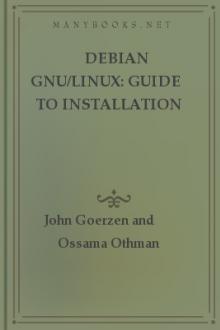Free as in Freedom by Sam Williams (ready to read books .TXT) 📕

- Author: Sam Williams
- Performer: 0596002874
Book online «Free as in Freedom by Sam Williams (ready to read books .TXT) 📕». Author Sam Williams
Stallman remembers the discussions vividly. “I was always in favor of immortality,” he says. “I was shocked that most people regarded immortality as a bad thing. How else would we be able to see what the world is like 200 years from now?”
Although a first-rank mathematician and first-rate debater, Stallman shied away from clear-cut competitive events that might have sealed his brilliant reputation.
Near the end of freshman year at Harvard, Breidbart recalls how Stallman conspicuously ducked the Putnam exam, a prestigious test open to math students throughout the U.S. and Canada. In addition to giving students a chance to measure their knowledge in relation to their peers, the Putnam served as a chief recruiting tool for academic math departments.
According to campus legend, the top scorer automatically qualified for a graduate fellowship at any school of his choice, including Harvard.
Like Math 55, the Putnam was a brutal test of merit. A six-hour exam in two parts, it seemed explicitly designed to separate the wheat from the chaff.
Breidbart, a veteran of both the Science Honors Program and Math 55, describes it as easily the most difficult test he ever took. “Just to give you an idea of how difficult it was,” says Breidbart, “the top score was a 120, and my score the first year was in the 30s. That score was still good enough to place me 101st in the country.”
Surprised that Stallman, the best student in the class, had passed on the test, Breidbart says he and a fellow classmate cornered him in the dining common and demanded an explanation. “He said he was afraid of not doing well,” Breidbart recalls.
Breidbart and the friend quickly wrote down a few problems from memory and gave them to Stallman. “He solved all of them,” Breidbart says, “leading me to conclude that by not doing well, he either meant coming in second or getting something wrong.”
Stallman remembers the episode a bit differently. “I remember that they did bring me the questions and it’s possible that I solved one of them, but I’m pretty sure I didn’t solve them all,” he says. Nevertheless, Stallman agrees with Breidbart’s recollection that fear was the primary reason for not taking the test. Despite a demonstrated willingness to point out the intellectual weaknesses of his peers and professors in the classroom, Stallman hated the notion of head-to-head competition.
“It’s the same reason I never liked chess,” says Stallman. “Whenever I’d play, I would become so consumed by the fear of making a single mistake that I would start making stupid mistakes very early in the game. The fear became a self-fulfilling prophecy.”
Whether such fears ultimately prompted Stallman to shy away from a mathematical career is a moot issue. By the end of his freshman year at Harvard, Stallman had other interests pulling him away from the field. Computer programming, a latent fascination throughout Stallman’s high-school years, was becoming a full-fledged passion.
Where other math students sought occasional refuge in art and history classes, Stallman sought it in the computer-science laboratory.
For Stallman, the first taste of real computer programming at the IBM New York Scientific Center had triggered a desire to learn more. “Toward the end of my first year at Harvard school, I started to have enough courage to go visit computer labs and see what they had. I’d ask them if they had extra copies of any manuals that I could read.”
Taking the manuals home, Stallman would examine machine specifications, compare them with other machines he already knew, and concoct a trial program, which he would then bring back to the lab along with the borrowed manual. Although some labs balked at the notion of a strange kid coming off the street and working on the lab machinery, most recognized competence when they saw it and let Stallman run the programs he had created.
One day, near the end of freshman year, Stallman heard about a special laboratory near MIT. The laboratory was located on the ninth floor an off-campus building in Tech Square, the newly built facility dedicated to advanced research. According to the rumors, the lab itself was dedicated to the cutting-edge science of artificial intelligence and boasted the cutting-edge machines and software programs to match.
Intrigued, Stallman decided to pay a visit.
The trip was short, about 2 miles on foot, 10 minutes by train, but as Stallman would soon find out, MIT and Harvard can feel like opposite poles of the same planet. With its maze-like tangle of interconnected office buildings, the Institute’s campus offered an aesthetic yin to Harvard’s spacious colonial-village yang. The same could be said for the student body, a geeky collection of ex-high school misfits known more for its predilection for pranks than its politically powerful alumni.
The yin-yang relationship extended to the AI Lab as well. Unlike Harvard computer labs, there was no grad-student gatekeeper, no clipboard waiting list for terminal access, no explicit atmosphere of “look but don’t touch.” Instead, Stallman found only a collection of open terminals and robotic arms, presumably the artifacts of some A.I. experiment.
Although the rumors said anybody could sit down at the terminals, Stallman decided to stick with the original plan. When he encountered a lab employee, he asked if the lab had any spare manuals it could loan to an inquisitive student. “They had some, but a lot of things weren’t documented,” Stallman recalls. “They were hackers after all.”
Stallman left with something even better than a manual: a job. Although he doesn’t remember what the first project was, he does remember coming back to the AI Lab the next week, grabbing an open terminal and writing software code.
Looking back, Stallman sees nothing unusual in the AI Lab’s willingness to accept an unproven outsider at first glance. “That’s the way it was back then,” he says. “That’s the way it still is now. I’ll hire somebody when I meet him if I see he’s good. Why wait?
Stuffy people who insist on putting bureaucracy into everything really miss the point. If a person is good, he shouldn’t have to go through a long, detailed hiring process; he should be sitting at a computer writing code.”
To get a taste of “bureaucratic and stuffy,” Stallman need only visit the computer labs at Harvard. There, access to the terminals was doled out according to academic rank. As an undergrad, Stallman usually had to sign up or wait until midnight, about the time most professors and grad students finished their daily work assignments. The waiting wasn’t difficult, but it was frustrating. Waiting for a public terminal, knowing all the while that a half dozen equally usable machines were sitting idle inside professors’ locked offices, seemed the height of illogic. Although Stallman paid the occasional visit to the Harvard computer labs, he preferred the more egalitarian policies of the AI Lab.
“It was a breath of fresh air,” he says. “At the AI Lab, people seemed more concerned about work than status.”
Stallman quickly learned that the AI Lab’s first-come, first-served policy owed much to the efforts of a vigilant few. Many were holdovers from the days of Project MAC, the Department of Defense-funded research program that had given birth to the first time-share operating systems. A few were already legends in the computing world. There was Richard Greenblatt, the lab’s in-house Lisp expert and author of MacHack, the computer chess program that had once humbled A.I.
critic Hubert Dreyfus. There was Gerald Sussman, original author of the robotic block-stacking program HACKER. And there was Bill Gosper, the in-house math whiz already in the midst of an 18-month hacking bender triggered by the philosophical implications of the computer game LIFE.See Steven Levy, Hackers (Penguin USA [paperback], 1984): 144. Levy devotes about five pages to describing Gosper’s fascination with LIFE, a math-based software game first created by British mathematician John Conway. I heartily recommend this book as a supplement, perhaps even a prerequisite, to this one.
Members of the tight-knit group called themselves “
hackers.” Over time, they extended the “hacker”
description to Stallman as well. In the process of doing so, they inculcated Stallman in the ethical traditions of the “hacker ethic .” To be a hacker meant more than just writing programs, Stallman learned. It meant writing the best possible programs. It meant sitting at a terminal for 36 hours straight if that’s what it took to write the best possible programs. Most importantly, it meant having access to the best possible machines and the most useful information at all times. Hackers spoke openly about changing the world through software, and Stallman learned the instinctual hacker disdain for any obstacle that prevented a hacker from fulfilling this noble cause.
Chief among these obstacles were poor software, academic bureaucracy, and selfish behavior.
Stallman also learned the lore, stories of how hackers, when presented with an obstacle, had circumvented it in creative ways. Stallman learned about ” lock hacking,”
the art of breaking into professors’ offices to “liberate” sequestered terminals. Unlike their pampered Harvard counterparts, MIT faculty members knew better than to treat the AI Lab’s terminal as private property. If a faculty member made the mistake of locking away a terminal for the night, hackers were quick to correct the error. Hackers were equally quick to send a message if the mistake repeated itself. “I was actually shown a cart with a heavy cylinder of metal on it that had been used to break down the door of one professor’s office,“Gerald Sussman, an MIT faculty member and hacker whose
work at the AI Lab predates Stallman’s, disputes this memory. According to Sussman, the hackers never broke any doors to retrieve terminals.
Stallman says.
Such methods, while lacking in subtlety, served a purpose. Although professors and administrators outnumbered hackers two-to-one inside the AI Lab, the hacker ethic prevailed. Indeed, by the time of Stallman’s arrival at the AI Lab, hackers and the AI Lab administration had coevolved into something of a symbiotic relationship. In exchange for fixing the machines and keeping the software up and running, hackers earned the right to work on favorite pet projects. Often, the pet projects revolved around improving the machines and software programs even further. Like teenage hot-rodders, most hackers viewed tinkering with machines as its own form of entertainment.
Nowhere was this tinkering impulse better reflected than in the operating system that powered the lab’s central PDP-6 mini-computer. Dubbed ITS, short for the Incompatible Time Sharing system, the operating system incorporated the hacking ethic into its very design.
Hackers had built it as a protest to Project MAC’s original operating system, the Compatible Time Sharing System, CTSS, and named it accordingly. At the time, hackers felt the CTSS design too restrictive, limiting programmers’ power to modify and improve the program’s own internal architecture if needed. According to one legend passed down by hackers, the decision to build ITS had political overtones as well. Unlike CTSS, which had been designed for the IBM 7094, ITS was built specifically for the PDP-6. In letting hackers write the systems themselves, AI Lab administrators guaranteed that only hackers would feel comfortable using the PDP-6. In the feudal world of academic research, the gambit worked. Although the PDP-6 was co-owned in conjunction with other departments, A.I.
researchers soon had it to





Comments (0)